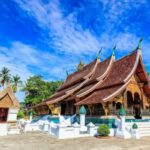Vientiane, capital city of Laos
Post on : 16 May, 2017 Vientiane is the capital and largest city of Laos, on the banks of the Mekong River near the border with Thailand. Vientiane became the capital in 1563 due to fears of a Burmese invasion but was later looted then razed to the ground in 1827 by the Siamese (Thai). […]
Vientiane is the capital and largest city of Laos, on the banks of the Mekong River near the border with Thailand. Vientiane became the capital in 1563 due to fears of a Burmese invasion but was later looted then razed to the ground in 1827 by the Siamese (Thai). Vientiane was the administrative capital during French rule and, due to economic growth in recent times, is now the economic center of Laos.
Location:
Vientiane is located on a curve of the Mekong River with total area of 3,920 square kilometers includes 09 districts: Chanthabouly, Sikhottabong, Xaysettha, Sisattanak, Naxaithong, Xaythany, Hadxaifong, Sangthong and Park Ngum. The population is about 610,000.
Climate:
The climate in this city features a tropical savanna climate with a distinct wet season and a dry season. Vientiane’s dry season spans from November through March. April marks the onset of the wet season which in Vientiane lasts about seven months. Vientiane tends to be hot and humid throughout the course of the year, though temperatures in the city tend to be somewhat cooler during the dry season than the wet season.
Tourism:

Pha That Luong
Although still a small city, the capital experiences a major influx of tourists. The city contains many temples and Buddhist monuments with Pha That Luang, a Buddhist stupa, one of the most famous in Laos. It is the most important national cultural monument and very popular amongst foreign tourists. The original was built in 1566 by King Setthathirath, and was restored in 1953. The golden stupa is 45 metres tall and is believed to contain a relic of the Lord Buddha.
Another site that is also popular amongst tourists is Wat Si Muang. The temple was built on the ruins of a Khmer Hindu shrine, the remains of which can be seen behind the ordination hall. It was built in 1563 and is believed to be guarded by the spirit of a local girl called “Si”. Legend says that Nang Si, who was pregnant at the time, leapt to her death as a sacrifice, just as the pillar was being lowered into the hole. In front of the temple stands a statue of King Sisavang Vong.
The memorial monument, Patuxai, began construction in 1957 and completed in 1968, is perhaps the most prominent landmark in the city. While the Arc de Triomphe in Paris inspired the architecture, the design incorporates typical Lao motifs including “Kinnari”, a mythical bird woman. Energetic visitors can climb to the top of the monument, which reveals an panoramic view of the city.
Buddha Park was built in 1958 by Luang Pu Bunleua Sulilat and contains a collection of Buddhist and Hindu sculptures, scattered amongst gardens and trees. The park was built about 28 kilometres south of Vientiane at the edge of the Mekong River.
Vientiane is home to one of the three bowling alleys in Laos (the other two are in Luang Prabang and Pakse). There are many upper-class hotels in Vientiane.
Besides, tourists can also visit sites such as: Haw Phra Kaew, Lao National Museum, Talat Sao Morning market, That Dam, Wat Ong Teu Mahawihan (Buddhist monastery), Wat Si Saket, Wat Sok Pa Luang, the Sanjiang market and so on.
Transportation:
There are regular bus services connecting Vientiane Bus Station with the rest of the country. In Vientiane, regular bus services around the city are provided by Vientiane Capital State Bus Enterprise.




